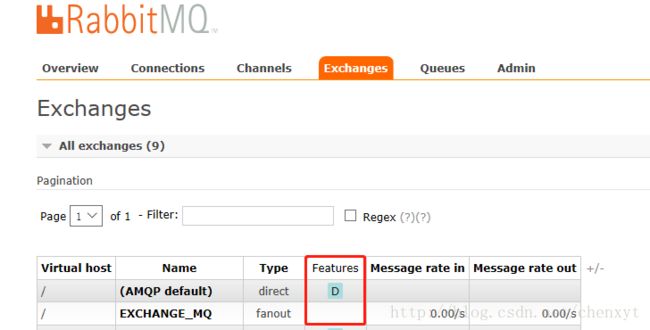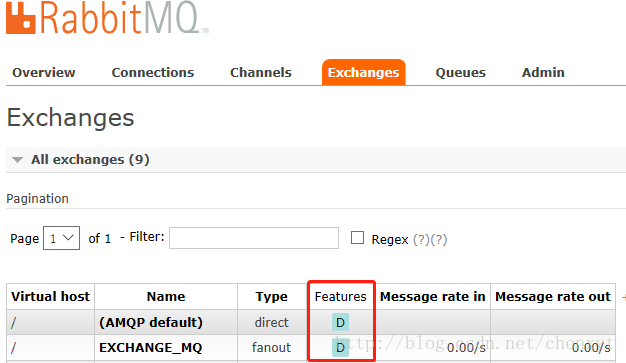RabbitMQ学习笔记七:交换机、队列、消息的持久化
一、概述
在生产过程中,难免会发生服务器宕机的事情,RabbitMQ也不例外,可能由于某种特殊情况下的异常而导致RabbitMQ宕机从而重启,那么这个时候对于消息队列里的数据,包括交换机、队列以及队列中存在消息恢复就显得尤为重要了。RabbitMQ本身带有持久化机制,包括交换机、队列以及消息的持久化。持久化的主要机制就是将信息写入磁盘,当RabbtiMQ服务宕机重启后,从磁盘中读取存入的持久化信息,恢复数据。(当然凡是都不是100%的,只能尽最大程度的保证消息不会丢失吧)
二、交换机的持久化
在前面的示例中,我们使用常规的声明交换机的方法
channel.exchangeDeclare(EXCHANGE_NAME,"fanout");使用这种方法声明的交换机,默认不是持久化的,在服务器重启之后,交换机会消失。我们在管理台的Exchange页签下查看交换机,可以看到使用上述方法声明的交换机,Features一列是空的,即没有任何附加属性。
我们换用另一种方法声明交换机
channel.exchangeDeclare(EXCHANGE_NAME, "fanout",true);查看一下方法的说明
/**
* Actively declare a non-autodelete exchange with no extra arguments
* @see com.rabbitmq.client.AMQP.Exchange.Declare
* @see com.rabbitmq.client.AMQP.Exchange.DeclareOk
* @param exchange the name of the exchange
* @param type the exchange type
* @param durable true if we are declaring a durable exchange (the exchange will survive a server restart)
* @throws java.io.IOException if an error is encountered
* @return a declaration-confirm method to indicate the exchange was successfully declared
*/
Exchange.DeclareOk exchangeDeclare(String exchange, String type, boolean durable) throws IOException;
我们可以看到第三个参数durable,如果为true时则表示要做持久化,当服务重启时,交换机依然存在,所以使用该方法声明的交换机是下面这个样子的(做测试的时候,需要先在管理台删掉原来的同名交换机)D表示durable,鼠标放在上边会显示为true
现在重启RabbitMQ服务之后,可以看到我们声明的交换机仍然存在。
三、队列的持久化
与交换机的持久化相同,队列的持久化也是通过durable参数实现的,默认生成的随机队列不是持久化的。前面示例中声明的带有我们自定义名字的队列都是持久化的。
channel.queueDeclare(QUEUE_NAME, true, false, false, null);看一下方法的定义
/**
* Declare a queue
* @see com.rabbitmq.client.AMQP.Queue.Declare
* @see com.rabbitmq.client.AMQP.Queue.DeclareOk
* @param queue the name of the queue
* @param durable true if we are declaring a durable queue (the queue will survive a server restart)
* @param exclusive true if we are declaring an exclusive queue (restricted to this connection)
* @param autoDelete true if we are declaring an autodelete queue (server will delete it when no longer in use)
* @param arguments other properties (construction arguments) for the queue
* @return a declaration-confirm method to indicate the queue was successfully declared
* @throws java.io.IOException if an error is encountered
*/
Queue.DeclareOk queueDeclare(String queue, boolean durable, boolean exclusive, boolean autoDelete,
Map arguments) throws IOException;
第二个参数跟交换机方法的参数一样,true表示做持久化,当RabbitMQ服务重启时,队列依然存在。这里说一下后边的三个参数,exclusive是排他队列,如果一个队列被声明为排他队列,那么这个队列只能被第一次声明他的连接所见,并在连接断开的时候自动删除。这里有三点需要说明,1、同一个连接的不同channel,是可以访问同一连接下创建的排他队列的。2、排他队列只能被声明一次,其他连接不允许声明同名的排他队列。3、及时排他队列是持久化的,当连接断开或者客户端退出时,排他队列依然会被删除。autoDelete是自动删除,为true时,当没有任何消费者订阅该队列时,队列会被自动删除。arguments:其它参数
四、消息的持久化
消息的持久化是指当消息从交换机发送到队列之后,被消费者消费之前,服务器突然宕机重启,消息仍然存在。消息持久化的前提是队列持久化,假如队列不是持久化,那么消息的持久化毫无意义。
通过如下代码设置消息的持久化
channel.basicPublish(EXCHANGE_NAME,"",MessageProperties.PERSISTENT_TEXT_PLAIN,message.getBytes());其中MessageProperties.PERSISTENT_TEXT_PLAIN是设置持久化的参数
我们查看basicPublish方法的定义
/**
* Publish a message
* @see com.rabbitmq.client.AMQP.Basic.Publish
* @param exchange the exchange to publish the message to
* @param routingKey the routing key
* @param props other properties for the message - routing headers etc
* @param body the message body
* @throws java.io.IOException if an error is encountered
*/
void basicPublish(String exchange, String routingKey, BasicProperties props, byte[] body) throws IOException;在看下BasicProperties的类型
public BasicProperties(
String contentType,
String contentEncoding,
Map headers,
Integer deliveryMode,
Integer priority,
String correlationId,
String replyTo,
String expiration,
String messageId,
Date timestamp,
String type,
String userId,
String appId,
String clusterId) 其中deliveryMode是设置消息持久化的参数,等于1不设置持久化,等于2设置持久化。PERSISTENT_TEXT_PLAIN是实例化的一个deliveryMode=2的对象,便于编程。
public static final BasicProperties PERSISTENT_TEXT_PLAIN =
new BasicProperties("text/plain",
null,
null,
2,
0, null, null, null,
null, null, null, null,
null, null);设置了队列的持久化和消息的持久化之后,当服务器宕机重启,存在队列中未发送的消息会依然存在。
以上就是关于RabbitMQ中持久化的一些内容,但是并不会严格的100%保证信息不会丢失,相关内容后续再说明。
五、总结

